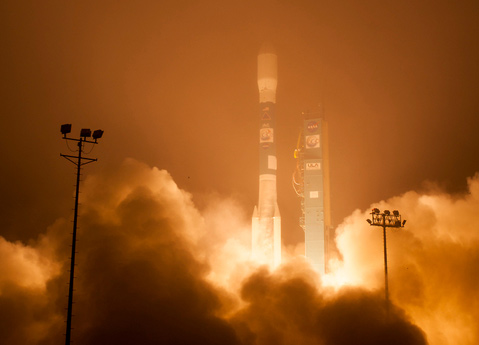NASA Blasts CO2 Monitoring Satellite into Space
Successful Launch Comes Four Years After Expensive Failure

At 2:56 a.m. on Wednesday morning at Vandenberg Air Force Base, a Delta II rocket ignited with a massive roar. Orange flame and billowing clouds of smoke obscured the launch pad, and within seconds, the rocket carrying NASA’s $464 million Orbiting Carbon Observatory-2 satellite rose above the fog of the Central California coast. Within moments, the OCO-2 had achieved speeds of Mach 10, ten times the speed of sound, and was headed into a polar orbit around the earth.
“We have lift-off of the Delta II rocket carrying the OCO-2 satellite tracking greenhouse gas and seeking clues to climate change,” said Flight Commander Steve Agid, who broadcast to journalists on the ground and around the world via NASA TV. Within an hour and ahead of schedule, the satellite separated from the launch vehicle into a 429-mile orbit around the Earth, established communications with both ground- and space-based networks, and unfurled its solar panels to collect energy.
“I am happy to report from an initial health check that we have a healthy observatory,” said Ralph Basilio, project manager for the Jet Propulsion Laboratory (JPL), with a smile. “We are power positive and on our way to completing the rest of the orbit and joining the loose formation of [NASA] satellites known as the A-Train. So beware, A-Train, we’re coming up there.”
The successful launch took the pressure off project scientists including Michael Gunson, an atmospheric chemist working on the mission for JPL in Pasadena. He admitted that the night before, when a launch attempt was scrubbed with just 45 seconds before ignition, he and hundreds of others watching at the site “sighed audibly” in disappointment.
A system designed to flood the pad with water at ignition, to protect it and suppress noise, had failed, forcing a cancellation for 24 hours. This brought to mind memories of the unsuccessful launch of the original OCO in February of 2009, which failed to separate from its Taurus XL rocket and crashed into the ocean near Antarctica.
The OCO-2, a carbon copy of the original OCO satellite from 2009, will attempt to answer an increasingly urgent question atmospheric scientists have been puzzling over for years.
“We’ve been slowly but surely increasing the inputs of carbon dioxide over time into the atmosphere, but it turns out that only about half that carbon dioxide stays there,” said project science leader David Crisp at a pre-launch press conference. “Half of the carbon dioxide is disappearing somewhere. About a quarter is dissolving into the ocean waters, we know that from our measurements, and the other quarter is going somewhere into the land biosphere. Somewhere — but we don’t know where. Have any of you seen a new rainforest springing into existence anywhere over the last 40 years or so?”
Crisp pointed out that carbon dioxide levels in the atmosphere are at its highest in at least 800,000 years, when temperatures were much warmer around the planet and sea levels considerably higher. Yet, for some reason, absorption rates have not been steady. “Although our inputs of carbon dioxide have been growing slowly and steadily over time, the amount that stays in the atmosphere varies dramatically,” he said. “Sometimes almost 100 percent of the carbon dioxide we put in the atmosphere stays there, sometimes almost none. We don’t know why.”
Although the mission is intended to answer scientific questions, the precision and global sweep of the satellite could also encourage policy makers to strike international treaties to control the emissions of carbon dioxide because for the first time, it may be possible to verify the exact amounts of CO2 released. Crisp admitted being concerned by what might happen to levels of carbon dioxide in the atmosphere if ocean temperatures continue to rise.
“We’re concerned that over time as it warms up, due to climate change, that the ocean will actually hold less carbon dioxide than it does today,” he said. “If you take a bottle of soda out of the refrigerator, and leave it out on the table for a little while, all the carbon dioxide goes away, and it becomes flat.”



